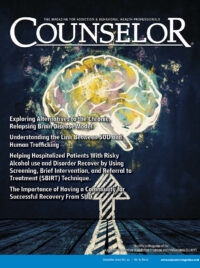Share
According to William White and William Cloud in their book, “Recovery Capital: A Primer for Addictions Professionals,” community recovery capital is a concept that supports the resolution of alcohol and other drug problems by encompassing community attitudes, policies, and resources that promote recovery (White & Cloud, 2008). The concept of recovery capital emerged in the years following the development of theory on the role of social capital in political and economic models. As defined by Robert Putnam, social capital includes features of social organization such as networks, norms, and trust that facilitate coordination and cooperation for mutual benefit (Putnam, 2000). Both definitions recognize that community has a role in the wellbeing of its members, social capital, by definition emphasizes the tension of forces that support and erode its formation.
While research on social capital has more broadly considered power relations and social structure that inhibit or promote mutually beneficial connections, much of the research on recovery capital has focused on individual wellness (White & Cloud, 2008). The tension of forces that support and erode recovery capital formation is often neglected, possibly because the focus is primarily on individual wellness, ignoring the inherent tensions within community recovery capital.
Research on social capital has often focused on economic dynamics, exploring how when markets fail or flourish, communities likewise strengthen or decay (Agrawal, 2001; Agrawal & Gibson, 2001). Analysis of these dynamics has helped us to understand how weak social capital can negatively impact economic or environmental outcomes. Social capital is also influenced by power relations and social structures (Ishihara & Pascual, 2009). Thus, it may be beneficial to consider how similar dynamics influence community formation of recovery capital in relation to government policy and the influence of the SUD treatment industry markets.
We often view the “work” of supporting recovery as an individualized and service-oriented dynamic for those with substance use conditions, rather than a community-based, relational process. The industry and government have historically focused on the development of products and services instead of community-oriented strengthening processes. This focus has resulted in a proliferation of tools to measure recovery capital on the individual level but little attention to the dynamics of recovery capital at the community level.
Communities must be active agents in their own healing. If we view healing primarily as a transactional matter at the individual level and not as a community-based, relational process, we will fail to fully realize ways to augment communities to foster their own capacity to heal. Seeing communities more as service recipients of marketable products, rather than primary drivers of their own wellness, fails to develop recovery capital in ways that harness the resiliency of communities in all their diversity.
Don Coyhis of White Bison uses the metaphor of a healing forest, wherein a vibrant treatment culture helps people initiate recovery, but a healthy, healing forest provides space in which recovery is invited, welcomed, and provided the soil to flourish over time. Building and protecting such physical, psychological, and social spaces is vital to enhancing the quality of personal and family life in long-term recovery. Such spaces must be created within all major social institutions.
We must better understand the dynamics that strengthen recovery in our communities. A broad societal focus on expanding hope, connection, and purpose within communities would be beneficial to changing the dynamic of our current addiction crisis. To realize the full capacity of recovery capital on the community level, we need to consider inhibitory factors in developing resources in our communities, with a particular focus on marginalized communities. Doing so would likely involve leveraging the resources in all our communities, rather than developing recovery capital one person at a time, so that community members can support each other.
Recovery is contagious and spreads through communities like ripples in water. We need to learn how to spread it and better understand what healing looks like at the community level. Longitudinal studies focused on the rich fabric of how each person in recovery not only improves their own lives but also positively influences their whole community would serve to understand what Dr. David Best terms the contagion of hope. Science focused on relational networks, norms, and trust as vital facets of community recovery capital would potentially be a game changer.
References
- Agrawal, B., (2001). Participatory exclusion, community forestry and gender: an analysis of South Asia and the conceptual framework. World Development. 29, 1623-1648.
- Agrawal, A., Gibson, C.C., (2001). The role of the community in natural resource reservation. Communities and the environment: ethnicity, gender, and the state in community-based conservation. Rutgers
- University Press, New Brunswick.
- Best, D. De Alwis, S. (2017). Community recovery as a public health intervention: The contagion of hope. Alcoholism Treatment Quarterly, 35 (3), 187-199.
- Best, D. W., Lubman, D. I., Savic, M., Wilson, A., Dingle, G. A., Haslam, C., … & Vanderplasschen, W. (2018). Social and recovery capital: Two key factors for successful addiction recovery. Journal of Substance Abuse Treatment, 84, 60-66. doi: 10.1016/j.jsat.2017.10.013
- Coyhis, D. (2002) The Red Road to Wellbriety. White Bison, Inc: Colorado Springs, CO.
- Ishihara, H., Pascual U. (2009). Social capital in community level environmental governance: A critique
- – Ecological Economics. Elsevier.
- McKnight, J., & Block, P. (2010). The abundant community: Awakening the power of families and neighborhoods. Berrett-Koehler Publishers
- Putnam, Robert D. 1995. “Bowling alone: America’s declining social capital.” Journal of Democracy 6: 65-78
- White, W. & Cloud, W. (2008). Recovery capital: A primer for addictions professionals.
- Counselor, 9(5), 22-27.
William Stauffer is the Executive Director of Pennsylvania Recovery Organization Alliance (PRO-A), the statewide recovery community organization of PA. He has run public SUD treatment and recovery community organizations for well over 3 decades and teaches Social Work at Misericordia University in Dallas PA. A person in long term recovery, in 2018, he testified to US Senate Special Committee on Aging on the opioid epidemic and older adults. William is the 2019 recipient of the Vernon Johnson Award Recovery Advocate of the year at the America Honors Recovery dinner. Recently, he served on Pennsylvania Governor Josh Shapiro’s transition team.











 Counselor Magazine is the official publication of the California Association of Addiction Programs and Professionals (CCAPP). Counselor offers online continuing education, article archives, subscription deals, and article submission guidelines. It has been serving the addiction field for more than thirty years.
Counselor Magazine is the official publication of the California Association of Addiction Programs and Professionals (CCAPP). Counselor offers online continuing education, article archives, subscription deals, and article submission guidelines. It has been serving the addiction field for more than thirty years.